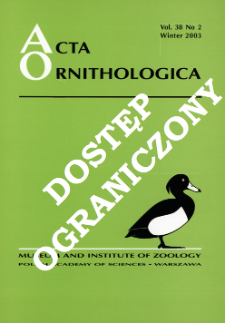
Object
Title: Birds breeding in a changing farmland
Subtitle:
Acta Ornithologica, vol. 36, no. 1 ; Ptaki lęgowe wobec zmian w rolnictwie
Contributor:
Polska Akademia Nauk. Muzeum i Instytut Zoologii ; Meeting of the European Ornithologists' Union (2 ; 1999 ; Gdańsk)
Publisher:
Muzeum i Instytut Zoologii PAN
Place of publishing:
Description:
Referat wygłoszony na Second Meeting of the European Ornithologists' Union ; Bibliogr. s. 45-51 ; S. [35]-51 : il. ; 27 cm ; Streszcz. pol. Nazwy taksonów także w jęz. łac.
Type of object:
Abstract:
As a result of intensified agriculture, farmland in Europe is the habitat where the most pronounced changes have occurred in recent decades. In parallel, breeding populations of birds have been declining over much of Europe. Today, farmland has the largest proportion of Red-List species. This paper reviews studies on the impact of agriculture on birds breeding in the farmland ecosystems of Europe: breeding bird density in relation to farming practice, effects of agriculture on foraging and feeding ecology while rearing young, and consequences for breeding success. Specialised bird species are most affected by farming practice. They are rare or even absent in intensively managed farmland with a much reduced habitat and structural diversity. As crops grow fast and as their vegetation is very dense, large fields become inaccessible to or unprofitable for ground feeding birds. To exploit alternative food resources, parents feeding nestlings have to cover larger distances to isolated and distant food patches. Reduced food availability in modern farmland and increased time and energy costs of foraging may result in lower body conditions of parent birds and their broods, in a reduced breeding success and lower survival. Some species breeding in intensively farmed areas are at least locally unable to produce sufficient recruits to maintain their numbers in the long term. Our knowledge of the breeding ecology and population dynamics of farmland birds is growing, but it is still based mainly on short-term and small-scale case studies on a few species. Little is known about whether measures to improve habitat quality (e.g. set-asides) are adequate to halt negative trends in bird populations. Hence, there is a need for internationally coordinated scientific work with important implications for conservation.
Relation:
Volume:
Issue:
Start page:
End page:
Detailed Resource Type:
Artykuł ; Materiały konferencyjne
Format:
Resource Identifier:
Source:
MiIZ PAN, patrz sygn. czas. P.257, Vol. 36, No ; MiIZ PAN, patrz sygn. czas. P.4568, Vol. 36, No 1 ; click here to follow the link
Language:
Rights:
Prawa zastrzeżone - dostęp ograniczony
Terms of use:
Digitizing institution:
Muzeum i Instytut Zoologii Polskiej Akademii Nauk
Original in:
Biblioteka Muzeum i Instytutu Zoologii PAN
Projects co-financed by:
Program Operacyjny Innowacyjna Gospodarka, lata 2010-2014, Priorytet 2. Infrastruktura strefy B + R ; Unia Europejska. Europejski Fundusz Rozwoju Regionalnego
Access:
Object collections:
- Digital Repository of Scientific Institutes > Partners' collections > Museum and Institute of Zoology PAS > Scientific Journals
- Digital Repository of Scientific Institutes > Partners' collections > Museum and Institute of Zoology PAS > MIZ PAN Publications > Acta Ornithologica
- Digital Repository of Scientific Institutes > Literature > Journals/Articles
Last modified:
Oct 2, 2020
In our library since:
May 23, 2014
Number of object content downloads / hits:
48
All available object's versions:
https://rcin.org.pl/publication/61297
Show description in RDF format:
Show description in RDFa format:
Show description in OAI-PMH format:
| Edition name | Date |
|---|---|
| Birds breeding in a changing farmland / Schifferli, Luc | Oct 2, 2020 |
Objects Similar
Nobel, Willebrordus Theodorus de (1965– ) Hagemeijer, Ward E. J. M. Majoor, Frank A. Teunissen, Wolf A. Valk, Rob van der
Reproduction and feeding success of the red-necked grebe Podiceps grisegena at fish ponds, SE Poland
Kloskowski, Janusz
Eguchi, Kazuhiro Takeishi, Masayoshi
Tomiałojć, Ludwik (1939– )
Górski, Wojciech (1946–2001) Kotlarz, Bogdan
Lebreton, Jean-Dominique (1950– )
Erskine, Anthony J. (1931– )

 INSTYTUT ARCHEOLOGII I ETNOLOGII POLSKIEJ AKADEMII NAUK
INSTYTUT ARCHEOLOGII I ETNOLOGII POLSKIEJ AKADEMII NAUK
 INSTYTUT BADAŃ LITERACKICH POLSKIEJ AKADEMII NAUK
INSTYTUT BADAŃ LITERACKICH POLSKIEJ AKADEMII NAUK
 INSTYTUT BADAWCZY LEŚNICTWA
INSTYTUT BADAWCZY LEŚNICTWA
 INSTYTUT BIOLOGII DOŚWIADCZALNEJ IM. MARCELEGO NENCKIEGO POLSKIEJ AKADEMII NAUK
INSTYTUT BIOLOGII DOŚWIADCZALNEJ IM. MARCELEGO NENCKIEGO POLSKIEJ AKADEMII NAUK
 INSTYTUT BIOLOGII SSAKÓW POLSKIEJ AKADEMII NAUK
INSTYTUT BIOLOGII SSAKÓW POLSKIEJ AKADEMII NAUK
 INSTYTUT CHEMII FIZYCZNEJ PAN
INSTYTUT CHEMII FIZYCZNEJ PAN
 INSTYTUT CHEMII ORGANICZNEJ PAN
INSTYTUT CHEMII ORGANICZNEJ PAN
 INSTYTUT FILOZOFII I SOCJOLOGII PAN
INSTYTUT FILOZOFII I SOCJOLOGII PAN
 INSTYTUT GEOGRAFII I PRZESTRZENNEGO ZAGOSPODAROWANIA PAN
INSTYTUT GEOGRAFII I PRZESTRZENNEGO ZAGOSPODAROWANIA PAN
 INSTYTUT HISTORII im. TADEUSZA MANTEUFFLA POLSKIEJ AKADEMII NAUK
INSTYTUT HISTORII im. TADEUSZA MANTEUFFLA POLSKIEJ AKADEMII NAUK
 INSTYTUT JĘZYKA POLSKIEGO POLSKIEJ AKADEMII NAUK
INSTYTUT JĘZYKA POLSKIEGO POLSKIEJ AKADEMII NAUK
 INSTYTUT MATEMATYCZNY PAN
INSTYTUT MATEMATYCZNY PAN
 INSTYTUT MEDYCYNY DOŚWIADCZALNEJ I KLINICZNEJ IM.MIROSŁAWA MOSSAKOWSKIEGO POLSKIEJ AKADEMII NAUK
INSTYTUT MEDYCYNY DOŚWIADCZALNEJ I KLINICZNEJ IM.MIROSŁAWA MOSSAKOWSKIEGO POLSKIEJ AKADEMII NAUK
 INSTYTUT PODSTAWOWYCH PROBLEMÓW TECHNIKI PAN
INSTYTUT PODSTAWOWYCH PROBLEMÓW TECHNIKI PAN
 INSTYTUT SLAWISTYKI PAN
INSTYTUT SLAWISTYKI PAN
 SIEĆ BADAWCZA ŁUKASIEWICZ - INSTYTUT TECHNOLOGII MATERIAŁÓW ELEKTRONICZNYCH
SIEĆ BADAWCZA ŁUKASIEWICZ - INSTYTUT TECHNOLOGII MATERIAŁÓW ELEKTRONICZNYCH
 MUZEUM I INSTYTUT ZOOLOGII POLSKIEJ AKADEMII NAUK
MUZEUM I INSTYTUT ZOOLOGII POLSKIEJ AKADEMII NAUK
 INSTYTUT BADAŃ SYSTEMOWYCH PAN
INSTYTUT BADAŃ SYSTEMOWYCH PAN
 INSTYTUT BOTANIKI IM. WŁADYSŁAWA SZAFERA POLSKIEJ AKADEMII NAUK
INSTYTUT BOTANIKI IM. WŁADYSŁAWA SZAFERA POLSKIEJ AKADEMII NAUK


































